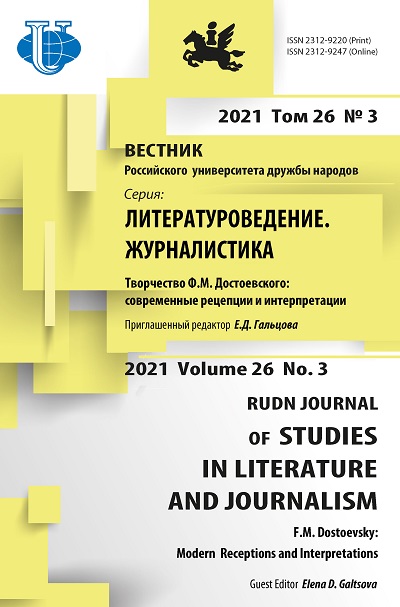The Polyphony of the Silent: The Specifics of Dostoevsky’s Philosophical Discourse
- Authors: Krinitsyn A.B.1
-
Affiliations:
- Moscow State University M.V. Lomonosov
- Issue: Vol 26, No 3 (2021): F.M. DOSTOEVSKY: MODERN RECEPTIONS AND INTERPRETATIONS
- Pages: 375-391
- Section: LITERARY CRITICISM
- URL: https://journals.rudn.ru/literary-criticism/article/view/27640
- DOI: https://doi.org/10.22363/2312-9220-2021-26-3-375-391
Cite item
Full Text
Abstract
The article describes the phenomenon of silence in Dostoevsky’s later prose. Philosophical, plot-forming and psychological aspects of silence are looked at. A confessional type of monologue is defined as a discursive genre, with specific roles of the speaker and his silent listeners, whose predominance in Dostoevsky’s prose lets the author of the article adjust the notion of polyphony and dialogue within the context of Dostoevsky’s poetics. The conventionality of “the other” in the confessional type of monologue is proved by the absence of the completing functions in listeners. In most cases Dostoevsky’s later works retain some rudimental forms of frantic dialogue while the role of specific monologue discourse, caused and conditioned by silence, is increasing. By semantics and function types of silence in Dostoevsky fall into three groups: 1) the underground silence as expression of human disunity in the epoch of “universal solitude”; 2) “role silence” of listeners in the discursive genre of confessional monologue; 3) sacred silence of Christ indicating transition to a new higher level of communication
About the authors
Alexandr B. Krinitsyn
Moscow State University M.V. Lomonosov
Author for correspondence.
Email: derselbe@list.ru
ORCID iD: 0000-0003-0262-5058
Doctor of Philology, Reader at the Department of the History of Russian Literature
Leninskie Gory, GSP, 1st building of Humanitarian Faculties, Moscow, 119991, Russian FederationReferences
- Bachtin, M.M. (1972). The problems of Dostoevsky’s poetics. Moscow: Khudozh. Literaturа Publ. (In Russ.)
- Bachtin, M.M. (1975). Esthetics of verbal fiction. Moscow: Iskusstvo Publ. (In Russ.)
- Shmid, V. (1994). Story-telling and the story being told in “Brothers Karamazov”. In V. Shmid. Prose as poetry: articles on narration in Russian literatre (pp. 142–150). Saint-Petersburg. (In Russ.)
- Epshtejn, M.N. (2006). Word and silence: Metaphysics of Russian literature: textbook for high schools. Moscow. (In Russ.)
- Dostoevskij, F.M. (1976). Complete works. Leningrad: Nauka Publ. (In Russ.)
- Krinicyn, A.B. (2016). The theory of plots in Dostoevsky’s novels. Moscow. (In Russ.)
- Zveig, Stefan. (1992). Three masters. Moscow. (In Russ.)
- Sartr, J.-P. (1988). Primary attitude to the other: love, language, masochism. In The problem of man in Western philosophy (pp. 227–228). Moscow. (In Russ.)
- Vitgenstein, L. (2005). Tractatus logico-philosoficus. In L. Vitgenstein Selected works (pp. 14–221). Moscow: Izdatel’skii dom «Territoriia budushchego» Publ. (In Russ.)
- Chirkov, N.M. (1967). On Dostievsky’s style: Problems. Ideas. Images. Moscow. (In Russ.)
















